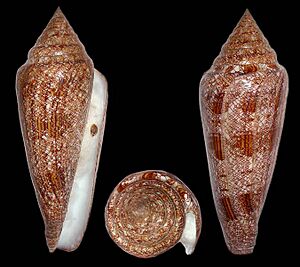Conus gloriamaris facts for kids
Quick facts for kids Conus gloriamaris |
|
|---|---|
 |
|
| Conus gloriamaris | |
| Conservation status | |
| Scientific classification | |
| Synonyms | |
|
Conus gloriamaris, common name the Glory of the Sea Cone, is a species of sea snail, a marine gastropod mollusk in the family Conidae, the cone snails, cone shells or cones. It is commonly found in the Pacific and Indian Oceans.
Contents
Description
The shell can reach 16 centimetres (6.3 in) in length, but typically measures between 8 and 12 centimetres (3.1 and 4.7 in). Compared with other cones, C. gloriamaris is relatively large, slender, with a tall spire. It is finely reticulated with orange-brown lines, enclosing triangular spaces similar to other textile cones, and two or three bands of chestnut hieroglyphic markings across its body. It is sometimes confused with the common Textile cone, and there is a similarity to the Bengal cone. The tan coloration can vary from a lighter, golden color to a deeper dark brown, with intricate detailing.
Collector value
The shell of this mollusc species has special significance to shell collectors because it was once regarded as the rarest shell in the world. For about two centuries between its initial discovery and the discovery of its habitat in 1969, specimens were valued in the thousands of U.S. dollars and generally only owned by museums and wealthy private collectors. Furthermore, the shell's popularity among collectors spawned urban legends, most notably the story of a collector purchasing one at auction in 1792 only to destroy it, to maintain the value of another one already in his collection. Improvements in diving technology such as the advent of scuba led to their discovery in larger numbers, and today shells can often be found from retailers or online auction sites for less than $100 U.S. Nonetheless, the legacy of this shell in addition to its pleasing shape and patterns makes it popular and desirable among shell collectors today.
Distribution
This is one of the many Indo-Pacific species of cone snail. It is found principally off the Solomon Islands but with a habitat ranging from the Philippines and eastern Indonesia, through New Guinea, and as far east as Samoa and Fiji.
Gallery






